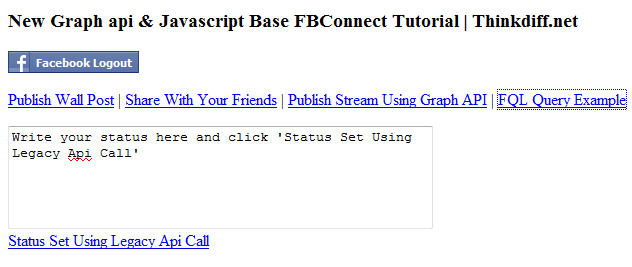 Some days ago facebook released their new graph api system to develop social sites more easily. Its really cool and I personally like the facebook’s new graph api system. Facebook also updated their old facebook connect system and provided better way to integrate facebook connect feature, user authentication and calling facebook api from website.
Some days ago facebook released their new graph api system to develop social sites more easily. Its really cool and I personally like the facebook’s new graph api system. Facebook also updated their old facebook connect system and provided better way to integrate facebook connect feature, user authentication and calling facebook api from website.In this article, I’ll highlight javascript base
- Facebook connect authentication for websites
- How to use graph api
- How to show stream publish prompt and share prompt
- How to run FQL query using javascript
- How to set status using old legacy api calling by javascript
Firstly you’ve to setup a facebook application to get the application id. You can setup application from here. Or if you have already setup a facebook application then just copy the application id and replace with xxxxxxxxxxx.
01 02 03 04 05 06 07 08 09 10 11 12 13 | <div id="fb-root"></div><script type="text/javascript"> window.fbAsyncInit = function() { FB.init({appId: 'xxxxxxxxxxxxxx', status: true, cookie: true, xfbml: true}); }; (function() { var e = document.createElement('script'); e.type = 'text/javascript'; e.src = document.location.protocol + '//connect.facebook.net/en_US/all.js'; e.async = true; document.getElementById('fb-root').appendChild(e); }()); |
And your html tag should be
1 2 | <!DOCTYPE html> |
01 02 03 04 05 06 07 08 09 10 11 12 13 14 15 16 17 18 19 20 | window.fbAsyncInit = function() { FB.init({appId: 'xxxxxxxxxxx', status: true, cookie: true, xfbml: true}); /* All the events registered */ FB.Event.subscribe('auth.login', function(response) { // do something with response login(); }); FB.Event.subscribe('auth.logout', function(response) { // do something with response logout(); }); FB.getLoginStatus(function(response) { if (response.session) { // logged in and connected user, someone you know login(); } }); }; |
Now we have to render fb connect button so that user can login or logout.
1 | <fb:login-button autologoutlink="true" perms="email,user_birthday,status_update,publish_stream"></fb:login-button> |
2. How to use graph api
To fully understand graph api visit the link . Now i’ll show how you can use graph api using javascript sdk. There is a method FB.api . This method directly hooks graph api and returns result. Sample code
1 2 3 | FB.api('/me', function(response) { alert(response.name);}); |
In my demo you’ll see another customized method graphStreamPublish(). This method uses FB.api() and does a HTTP POST request to http://graph.facebook.com/me/feed url with message parameter. So that the message will publish to users own wall.
01 02 03 04 05 06 07 08 09 10 | function graphStreamPublish(){ var body = 'Reading New Graph api & Javascript Base FBConnect Tutorial'; FB.api('/me/feed', 'post', { message: body }, function(response) { if (!response || response.error) { alert('Error occured'); } else { alert('Post ID: ' + response.id); } }); } |
There is another javascript sdk method named FB.ui. Using the code you can prompt user for stream publish or share your page. Checkout streamPublish() and share() methods defination in my demo’s source code .
4. How to run FQL query using javascript
Facebook Query Language enables you to use a SQL-style interface to query the data exposed by the Graph API. It provides for some advanced features not available in the Graph API, including batching multiple queries into a single call. Checkout the tables to know which data of facebook user you can retrieve. In the demo’s source code you’ll see
01 02 03 04 05 06 07 08 09 10 11 | function fqlQuery(){ FB.api('/me', function(response) { var query = FB.Data.query('select name, hometown_location, sex, pic_square from user where uid={0}', response.id); query.wait(function(rows) { document.getElementById('name').innerHTML = 'Your name: ' + rows[0].name + "<br />" + '<img src="' + rows[0].pic_square + '" alt="" />' + "<br />"; }); }); } |
5. How to set status using old legacy api calling by javascript
You can still call the old legacy api. In my demo you’ll see a text box, write something and click ‘Status Set Using Legacy Api Call’ You’ll see your facebook status will update.
01 02 03 04 05 06 07 08 09 10 11 12 13 14 15 16 17 | function setStatus(){ status1 = document.getElementById('status').value; FB.api( { method: 'status.set', status: status1 }, function(response) { if (response == 0){ alert('Your facebook status not updated. Give Status Update Permission.'); } else{ alert('Your facebook status updated'); } } ); } |
Hope this article will help you to make facebook connected social site.
Here is my demo’s full source code:
001 002 003 004 005 006 007 008 009 010 011 012 013 014 015 016 017 018 019 020 021 022 023 024 025 026 027 028 029 030 031 032 033 034 035 036 037 038 039 040 041 042 043 044 045 046 047 048 049 050 051 052 053 054 055 056 057 058 059 060 061 062 063 064 065 066 067 068 069 070 071 072 073 074 075 076 077 078 079 080 081 082 083 084 085 086 087 088 089 090 091 092 093 094 095 096 097 098 099 100 101 102 103 104 105 106 107 108 109 110 111 112 113 114 115 116 117 118 119 120 121 122 123 124 125 126 127 128 129 130 131 132 133 134 135 136 137 138 139 140 141 142 143 144 145 146 147 148 | <!DOCTYPE html> <head> <meta http-equiv="Content-Type" content="text/html; charset=UTF-8"/> <title>New Graph api & Javascript Base FBConnect Tutorial | Thinkdiff.net</title> </head> <body> <div id="fb-root"></div> <script type="text/javascript"> window.fbAsyncInit = function() { FB.init({appId: '113700398662301', status: true, cookie: true, xfbml: true}); /* All the events registered */ FB.Event.subscribe('auth.login', function(response) { // do something with response login(); }); FB.Event.subscribe('auth.logout', function(response) { // do something with response logout(); }); FB.getLoginStatus(function(response) { if (response.session) { // logged in and connected user, someone you know login(); } }); }; (function() { var e = document.createElement('script'); e.type = 'text/javascript'; e.src = document.location.protocol + '//connect.facebook.net/en_US/all.js'; e.async = true; document.getElementById('fb-root').appendChild(e); }()); function login(){ FB.api('/me', function(response) { document.getElementById('login').style.display = "block"; document.getElementById('login').innerHTML = response.name + " succsessfully logged in!"; }); } function logout(){ document.getElementById('login').style.display = "none"; } //stream publish method function streamPublish(name, description, hrefTitle, hrefLink, userPrompt){ FB.ui( { method: 'stream.publish', message: '', attachment: { name: name, caption: '', description: (description), href: hrefLink }, action_links: [ { text: hrefTitle, href: hrefLink } ], user_prompt_message: userPrompt }, function(response) { }); } function showStream(){ FB.api('/me', function(response) { //console.log(response.id); streamPublish(response.name, 'Thinkdiff.net contains geeky stuff', 'hrefTitle', 'http://thinkdiff.net', "Share thinkdiff.net"); }); } function share(){ var share = { method: 'stream.share', }; FB.ui(share, function(response) { console.log(response); }); } function graphStreamPublish(){ var body = 'Reading New Graph api & Javascript Base FBConnect Tutorial'; FB.api('/me/feed', 'post', { message: body }, function(response) { if (!response || response.error) { alert('Error occured'); } else { alert('Post ID: ' + response.id); } }); } function fqlQuery(){ FB.api('/me', function(response) { var query = FB.Data.query('select name, hometown_location, sex, pic_square from user where uid={0}', response.id); query.wait(function(rows) { document.getElementById('name').innerHTML = 'Your name: ' + rows[0].name + "<br />" + '<img src="' + rows[0].pic_square + '" alt="" />' + "<br />"; }); }); } function setStatus(){ status1 = document.getElementById('status').value; FB.api( { method: 'status.set', status: status1 }, function(response) { if (response == 0){ alert('Your facebook status not updated. Give Status Update Permission.'); } else{ alert('Your facebook status updated'); } } ); } </script> <h3>New Graph api & Javascript Base FBConnect Tutorial | Thinkdiff.net</h3> <p><fb:login-button autologoutlink="true" perms="email,user_birthday,status_update,publish_stream"></fb:login-button></p> <p> <a href="#" onclick="showStream(); return false;">Publish Wall Post</a> | <a href="#" onclick="share(); return false;">Share With Your Friends</a> | <a href="#" onclick="graphStreamPublish(); return false;">Publish Stream Using Graph API</a> | <a href="#" onclick="fqlQuery(); return false;">FQL Query Example</a> </p> <textarea id="status" cols="50" rows="5">Write your status here and click 'Status Set Using Legacy Api Call'</textarea> <br /> <a href="#" onclick="setStatus(); return false;">Status Set Using Legacy Api Call</a> <br /><br /><br /> <div id="login" style ="display:none"></div> <div id="name"></div> </body></html> |

No comments:
Post a Comment